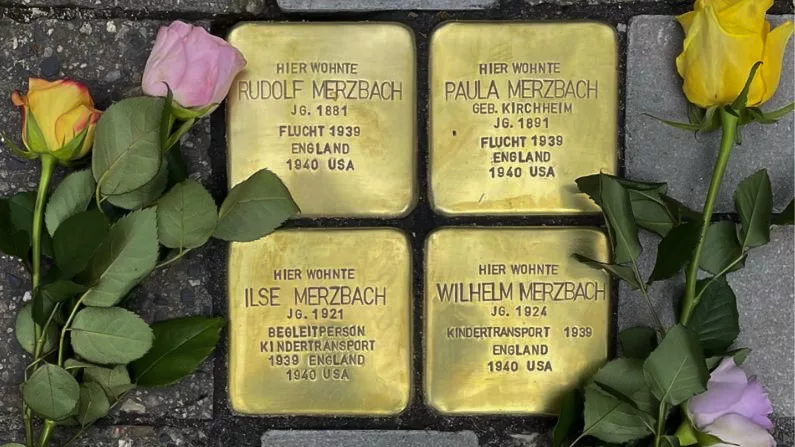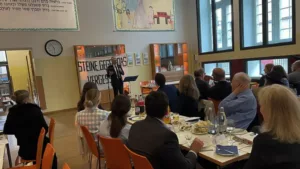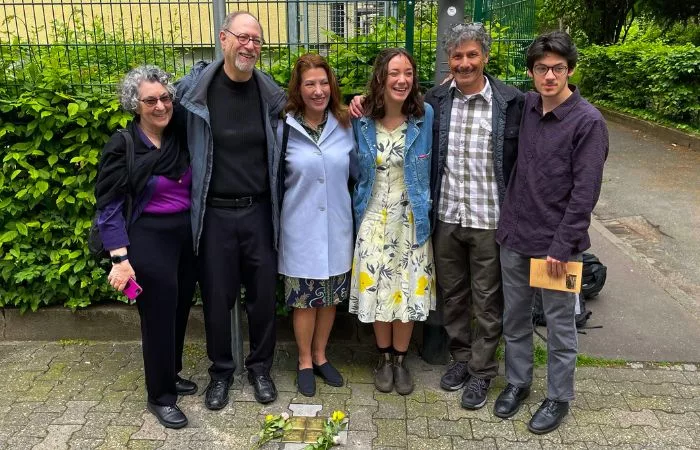Tens of thousands of victims and survivors of the Holocaust are being honored in Germany. It’s part of a three decades-old grassroots effort to create the world’s largest decentralized memorial, by placing special stones at the sites where residents once lived and welcoming back their families.
Those behind the movement say it’s especially important right now to remember the atrocities of the past. In recent years, both Germany and the U.S. have seen a rise in antisemitism.
KHOL reporter Hanna Merzbach descends from a Jewish family who fled the Nazis in World War II. She recently traveled to Germany to take part in one of the ceremonies and documented her experience.
Stolpersteine
On a residential block outside of downtown Frankfurt, about 40 people gathered on the sidewalk. My dad, brother and I flew out for the memorial for members of my family — the Merzbachs.
My cousin Bob Jesselson, from South Carolina, is the self-proclaimed historian of the family, and a professional cellist.
Before getting out his bow to play a song at the gathering, he pointed to the small, brass plaques being installed on the walkway. They’re called Stolpersteine.
“This means stumbling stones,” explains Jesselson, who speaks German. “So, the idea is as you walk on the sidewalk, you see the names of the people who lived there and you stumble over them.
But, he added, “you don’t really stumble because they’re flat.”
Some stones honor people who died in the Holocaust. Others are for those, like my grandfather’s family, who survived by leaving Germany.
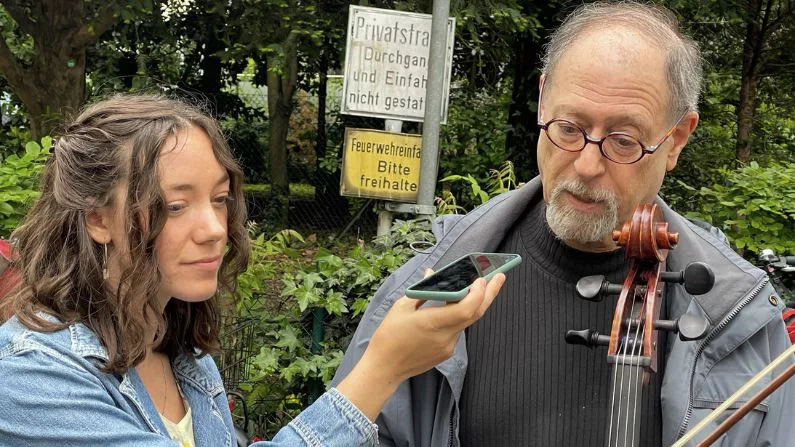
Reporter Hanna Merzbach learns about her family history from her cousin, Bob Jesselson. (Ralph Merzbach)
We were standing in front of where his family used to live. Today, birds chirp and trees blow in the wind, but Jesselson tells me the neighborhood wasn’t always so peaceful.
“The house doesn’t exist anymore,” he said. “It was all bombed during the war.”
Looking at the new concrete apartment buildings hovering above, it’s hard for me to imagine what Frankfurt looked like then.
When I was growing up in Los Angeles, my grandfather didn’t talk much about what he went through. But on this trip, I learned that his father narrowly escaped a concentration camp and that the family got out mere months before the second world war broke out. Then, they assimilated to life in the U.S. and never moved back to Germany.
Now, German citizens are honoring this history.
“The Germans are the ones who pay for it and sponsor it,” Jesselson said.
A grassroots movement
On that partly cloudy afternoon, Gunter Demnig was kneeling down, cementing the stones into place. He’s a silver-haired man in a flat-brimmed hat, with a denim shirt and a thick German accent.
He said, as opposed to mass memorials, this project is all about commemorating individuals.
“This is important to bring back the names,” Demnig said. “A man is forgotten and his name is forgotten.”
My grandfather’s stone reads “hier wohnte (here lived) Wilhelm Merzbach.”
It’s now one of a hundred thousand stones Demnig has laid across Europe. He started the effort thirty years ago.
“Now their name is back, and that’s very important,” he said.
Demnig said the stones honor all people persecuted under the Nazi regime. That includes Jews, like my family, but also people oppressed because of their sexual orientation or political beliefs.
“I think it’s important for the young people,” Demnig explained. “People want to know how could this happen? And please never happen again.”
A recent nationwide survey in the U.S. found that two-thirds of young adults are unaware that six million Jews were killed in the Holocaust.
Frankfurt resident Sibylle Stein is part of the movement to help remember victims of the Holocaust. She sponsored my family’s stones.
“There are some emotional connections,” she told me after the ceremony.
Stein, who mostly speaks German, said the story of the Merzbachs reminds her of her own family, who were persecuted for their political beliefs.
Alarming trends
According to Freedom House, which tracks democracy, we’re approaching a nearly two-decade decline in political rights and civil liberties around the world.
Stein said she’s worried about the future.
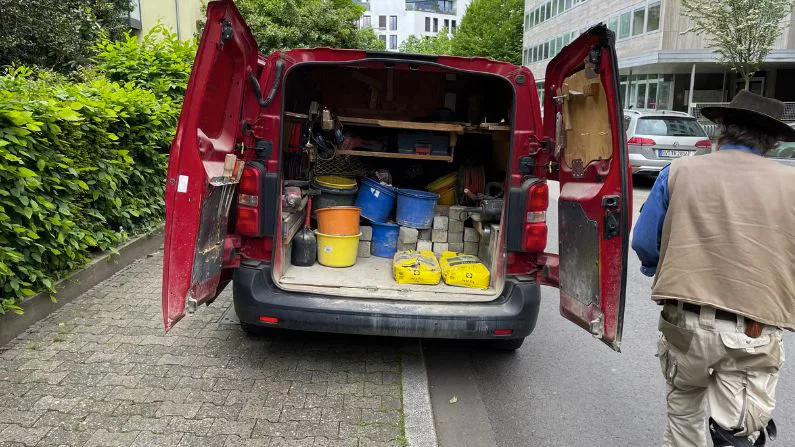
Gunter Demnig lays each stumbling stone himself, in an effort to preserve the memory of Holocaust victims and survivors. (Ralph Merzbach)
“I’m very, very interested in this history,” Stein said. “And I don’t want the right [wing] people in Germany, in the U.S.A, in every county, [to] gather again.”
Martin Dill runs the Stolpersteine initiative in Frankfurt. He said he sees trends today that happened leading up to the Holocaust.
“It happened from racism,” he said. “It happened from nationalism. It happened from chauvinism. It happened from antisemitism.”
Antisemitism has been on the rise in recent years in both Germany and the United States. Last year, the Anti-Defamation League counted the highest number of antisemitic acts in the U.S. since the group started keeping track 40 years ago.
Just last month, the Biden Administration introduced the country’s first strategic plan for combating the growing problem. Germany introduced a new strategy to fight antisemitism last year.
“The right wing politicians, the antidemocratic politicians, they are on the rise again and therefore we have to remember where this road might end,” Dill said.
‘An evening of encounter’
Later that day, after the Merzbach memorial, Dill hosted a Stolpersteine reception. He deemed it “an evening of encounter.”
My family joined about 25 other families — all descendants of Holocaust victims and survivors — at a Jewish elementary school in Frankfurt. Many of our parents and grandparents used to go there.
Beneath banners with Hebrew prayers, the descendants stood up and told their stories, many of which sounded like that of my own family.
They came from across Europe and the U.S for their relatives’ memorials.
Jesselson, my cousin, stood before the crowd and read a poem about the meaning of the stumbling stones — or Stolpersteine.
“When we stumble on the Stolpersteine, we step through time to a distant past,” he said. “We can see our parents as young children.”
Jesselson continued to say our families lived there for generations and were proud to be German.
“How did it feel for them to lose everything?” he asked. “Were they scared? Were they excited by the prospects of the future? Were they sad to be leaving?”
The answers to those questions, we may never know.
But, I did walk away from Germany with some other answers about my family’s history — where they lived, what that may have looked like and how they left — and thanks to this trip, those stumbling stones are sparking new family conversations.

